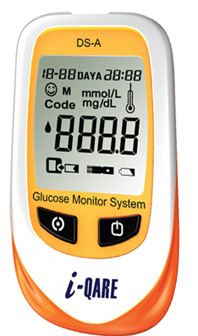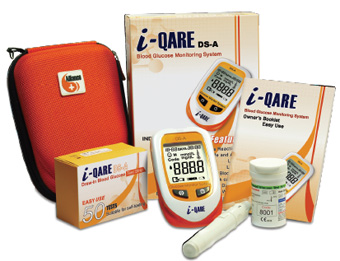
Diabetes is considered as one of the diseases of longevity or diseases of civilisation of the 21st century, also often regarded as a silent killer and threat to people's health, medical institutes and social economies. According to the International Diabetes Federation, each year worldwide, more than 3.8 million people die from diabetes-related causes, one death in every 10 seconds; the figure continuously growing yearly. The total number is expected to increase to over 380 million people by 2025. Furthermore, the cost of diabetes treatment is increasing, making great impact on global medical expenses. Thus, "prevention is better than cure" is not only the best policy to solve this civilisation disease but also a way to mitigate the silent burden to today's society. Nowadays, self-monitoring glucose meters play a vital role for diabetics; an efficient, cost-effective way of prevention of diabetes. The rate of use of home-care self-monitoring glucose monitors has been constantly going up. Glucometer manufacturers and the business sectors mostly emphasise on different features and functions of the medical device. However, how to choose a self-suitable glucose monitor is an important consideration for the consumer. Below are the features of what makes a reliable blood glucose monitor. Large Screen with Ergonomic Design Reading result is extremely important, especially for diabetics or elders who have poor eyesight. If the screen is not clear or big enough, misreading of test results could lead to wrong diagnosis or complications for the patient. Easy of Use The easier, the better. Diabetics must perform the test every single day. Easy operation helps them maintain this "routine" and keep track of their glucose level easily, especially for senior citizens. Complicated operation is not advisable for daily monitoring of blood sugar level. Memory Storage How many sets of memory space are enough? There's no correct answer because it depends on the user's needs. Normally, between 200 and 250 sets of memory are adequate. Accuracy This is definitely the key point that users care about most. Meters and strips should pass international standards, such as FDA, CE, ISO series, GMP, IEC and EMC, and must undergo clinical trials before mass production. Assurance of a narrow error range from 15% to 20% is important.

Fast Testing Time Diabetics check their blood sugar level more than three times a day. Checking of results should only take 5 to 10 seconds testing time. Less Pain Choosing the most suitable size of the lancet or lancing device is important to avoid more pain using large-sized lancets. Normally, 28G to 30G lancets can be purchased from pharmacies, hospitals, clinics and distributors. Support Prompt after-sales customer support is essential. Always check for the manufacturer's customer service number on the manual or packaging before you purchase the device. Self-monitoring blood glucose meters are essential in the lives of diabetics and their families. It is therefore necessary to have an informed choice when buying medical devices that would greatly affect the lives of the people we love. Source: Alliance International Alliance International Blood Glucose Monitoring System possesses all the recommended features of an efficient, cost-effective self-monitoring blood glucose monitor.
Zoom Lebron XI 11 Diabetes is considered as one of the diseases of longevity or diseases of civilisation of the 21st century, also often regarded as a silent killer and threat to people's health, medical institutes and social economies. According to the International Diabetes Federation, each year worldwide, more than 3.8 million people die from diabetes-related causes, one death in every 10 seconds; the figure continuously growing yearly. The total number is expected to increase to over 380 million people by 2025. Furthermore, the cost of diabetes treatment is increasing, making great impact on global medical expenses. Thus, "prevention is better than cure" is not only the best policy to solve this civilisation disease but also a way to mitigate the silent burden to today's society. Nowadays, self-monitoring glucose meters play a vital role for diabetics; an efficient, cost-effective way of prevention of diabetes. The rate of use of home-care self-monitoring glucose monitors has been constantly going up. Glucometer manufacturers and the business sectors mostly emphasise on different features and functions of the medical device. However, how to choose a self-suitable glucose monitor is an important consideration for the consumer. Below are the features of what makes a reliable blood glucose monitor. Large Screen with Ergonomic Design Reading result is extremely important, especially for diabetics or elders who have poor eyesight. If the screen is not clear or big enough, misreading of test results could lead to wrong diagnosis or complications for the patient. Easy of Use The easier, the better. Diabetics must perform the test every single day. Easy operation helps them maintain this "routine" and keep track of their glucose level easily, especially for senior citizens. Complicated operation is not advisable for daily monitoring of blood sugar level. Memory Storage How many sets of memory space are enough? There's no correct answer because it depends on the user's needs. Normally, between 200 and 250 sets of memory are adequate. Accuracy This is definitely the key point that users care about most. Meters and strips should pass international standards, such as FDA, CE, ISO series, GMP, IEC and EMC, and must undergo clinical trials before mass production. Assurance of a narrow error range from 15% to 20% is important.
Diabetes is considered as one of the diseases of longevity or diseases of civilisation of the 21st century, also often regarded as a silent killer and threat to people's health, medical institutes and social economies. According to the International Diabetes Federation, each year worldwide, more than 3.8 million people die from diabetes-related causes, one death in every 10 seconds; the figure continuously growing yearly. The total number is expected to increase to over 380 million people by 2025. Furthermore, the cost of diabetes treatment is increasing, making great impact on global medical expenses. Thus, "prevention is better than cure" is not only the best policy to solve this civilisation disease but also a way to mitigate the silent burden to today's society. Nowadays, self-monitoring glucose meters play a vital role for diabetics; an efficient, cost-effective way of prevention of diabetes. The rate of use of home-care self-monitoring glucose monitors has been constantly going up. Glucometer manufacturers and the business sectors mostly emphasise on different features and functions of the medical device. However, how to choose a self-suitable glucose monitor is an important consideration for the consumer. Below are the features of what makes a reliable blood glucose monitor. Large Screen with Ergonomic Design Reading result is extremely important, especially for diabetics or elders who have poor eyesight. If the screen is not clear or big enough, misreading of test results could lead to wrong diagnosis or complications for the patient. Easy of Use The easier, the better. Diabetics must perform the test every single day. Easy operation helps them maintain this "routine" and keep track of their glucose level easily, especially for senior citizens. Complicated operation is not advisable for daily monitoring of blood sugar level. Memory Storage How many sets of memory space are enough? There's no correct answer because it depends on the user's needs. Normally, between 200 and 250 sets of memory are adequate. Accuracy This is definitely the key point that users care about most. Meters and strips should pass international standards, such as FDA, CE, ISO series, GMP, IEC and EMC, and must undergo clinical trials before mass production. Assurance of a narrow error range from 15% to 20% is important.  Fast Testing Time Diabetics check their blood sugar level more than three times a day. Checking of results should only take 5 to 10 seconds testing time. Less Pain Choosing the most suitable size of the lancet or lancing device is important to avoid more pain using large-sized lancets. Normally, 28G to 30G lancets can be purchased from pharmacies, hospitals, clinics and distributors. Support Prompt after-sales customer support is essential. Always check for the manufacturer's customer service number on the manual or packaging before you purchase the device. Self-monitoring blood glucose meters are essential in the lives of diabetics and their families. It is therefore necessary to have an informed choice when buying medical devices that would greatly affect the lives of the people we love. Source: Alliance International Alliance International Blood Glucose Monitoring System possesses all the recommended features of an efficient, cost-effective self-monitoring blood glucose monitor.Zoom Lebron XI 11
Fast Testing Time Diabetics check their blood sugar level more than three times a day. Checking of results should only take 5 to 10 seconds testing time. Less Pain Choosing the most suitable size of the lancet or lancing device is important to avoid more pain using large-sized lancets. Normally, 28G to 30G lancets can be purchased from pharmacies, hospitals, clinics and distributors. Support Prompt after-sales customer support is essential. Always check for the manufacturer's customer service number on the manual or packaging before you purchase the device. Self-monitoring blood glucose meters are essential in the lives of diabetics and their families. It is therefore necessary to have an informed choice when buying medical devices that would greatly affect the lives of the people we love. Source: Alliance International Alliance International Blood Glucose Monitoring System possesses all the recommended features of an efficient, cost-effective self-monitoring blood glucose monitor.Zoom Lebron XI 11
 iConnectHub
iConnectHub
 Login/Register
Login/Register Supplier Login
Supplier Login


























